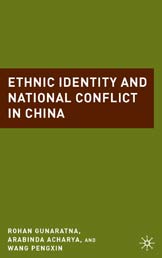A Review of: “Rohan Gunaratna, Arabinda Acharya, and Wang Pengxin. Ethnic Identity and National Conflict in China.”
New York: Palgrave Macmillan, 2010. 240 pp., $85.00 paper. ISBN: 978-0-230-10305-4.
Author: Andrew T. H. Tana
Affiliation: a University of New South Wales, Sydney, Australia
DOI: 10.1080/09546553.2011.554299
Article Requests: Order Reprints : Request Permissions
Published in: Terrorism and Political Violence, Volume 23, Issue 2 April 2011 , pages 318 - 320
Publication Frequency: 4 issues per year
To cite this Article: Tan, Andrew T. H. 'A Review of: “Rohan Gunaratna, Arabinda Acharya, and Wang Pengxin. Ethnic Identity and National Conflict in China.”', Terrorism and Political Violence, 23:2, 318 - 320
Despite having one of the world's largest Muslim populations and having faced terrorist attacks in contemporary times, China's radical Islamist problem has received an ambivalent response in the West. This is due to the perception that China has deliberately exaggerated the terrorist threat in order to justify an authoritarian crackdown on opposition to the present communist regime in Beijing. This ambivalence can be attributed to a strong bias against the communist regime and apprehension in the West over the emergence of China as a global power. There has thus been a lack of scholarship on the extent of the threat, its linkages with Al Qaeda and global terrorism, and the problems and prospects for China's counter-terrorism strategy.
This book is therefore important and timely, filling an important gap in the existing literature and scholarship. It studies China's radical Islamist problem with objectivity and tries to assess how China can better manage the growing challenge. The principal author, Rohan Gunaratna, is a counter-terrorism expert best known for his earlier work on Al Qaeda, and he and his co-authors were engaged by the Chinese authorities to assess the terrorism threat to the Beijing Olympics, as well as to the country more generally. This book has thus been the product of extensive fieldwork and consultation within China, lending it authenticity and authority in its analyses.
The book has, apart from a useful introduction and a conclusion, six chapters, which cover: a theoretical framework, a historical survey of Islam in China, the Uighur separatism in Xinjiang, the discourses on the origin and identity of Hui (i.e., non-Uighur) Muslims and the potential for their radicalization, the threat from transnational groups such as Al Qaeda and its associates, and China's counter-terrorism policies and strategy.
The book points out that attempted and actual terrorist attacks in the lead-up to the Beijing Olympics demonstrate that the terrorist threat from religious extremism exists in China. The East Turkistan Islamic Movement (ETIM), a federation of radical groups with linkages to Al Qaeda, has been at the core of this emerging terrorist challenge. The book documents the growing links between Uighur extremists and the global jihadist movement. There is also evidence that Al Qaeda is focusing its attention on China, given the problems in Xinjiang. Indeed, the rise of China as a great power is seen by radical Islamists to be a negative development, as in the eyes of Al Qaeda, China might behave like the United States—carrying out tasks such as protecting Jews and corrupt Muslim governments in the Middle East. Importantly, the book also explains how minority identity in China has developed historically, where Islam, and not just ethnicity alone, has shaped Muslim identity vis--vis the majority Han Chinese. The result is that religion is now at the root of the hardening of that separate identity, which has manifested itself in extremism and terrorist acts against the state.
The authors are not afraid to criticize China's counter-terrorism approach. For instance, they fault China for conflating terrorism, armed resistance, and peaceful protests, and for its tendency to lump all disparate opposition forces as part of a single threat to security. They argue that China's use of tough law enforcement tactics may have alienated the Muslim minorities. They point out that despite well-intentioned development projects, the Muslim minorities have felt disadvantaged and left out, as well as fearful over the erosion of their ethno-religious identity. The book concludes with the observation that nation-building cannot be achieved with attempts to assimilate the minorities by force, where minority identities and aspirations are in sharp contrast to those of the state. The authors argue that there is a “need for moderation and a more human approach” (the title of the conclusion), with policies that focus less on the use of force and more on how to win hearts and minds. They call for policies of inclusion, as well as significant investment in development projects in the affected areas aimed at enhancing the comprehensive political, economic, and social security of the local communities.
In focusing attention on the radical Islamist challenge in China, already regarded by Al Qaeda as a major field in the global jihad, this book makes an important, timely, and objective contribution to the literature on terrorism studies and should be read by all interested in counter-terrorism.

No comments:
Post a Comment